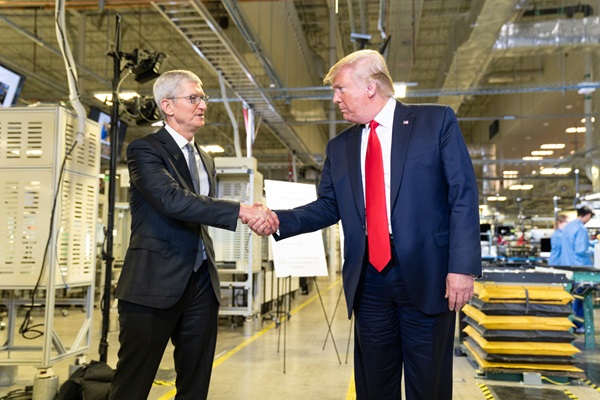.png)
Why Tim Cook Should Listen To Trump, Shift iPhone Assembly To US
India gains little from shallow iPhone assembly but could benefit from deeper reforms—chips, displays, batteries—and a correction in inflated US trade deficit figures.


Ajay Srivastava, founder of Global Trade Research Initiative, is an ex-Indian Trade Service officer with expertise in WTO and FTA negotiations.
May 16, 2025 at 5:50 AM IST
At a business summit in Doha on May 15, US President Donald Trump revealed that he had asked Apple CEO Tim Cook to halt the expansion of iPhone assembly operations in India. “I don’t want you building in India... They can take care of themselves,” Trump said, urging Cook to bring production home.
The proposal deserves serious consideration for what it can deliver.
Each $1,000 iPhone carries the imprint of at least a dozen countries. Apple, through its software, design, and brand, claims the lion’s share of the value—about $450 per device. US component makers such as Qualcomm and Broadcom add another $80. Taiwan earns $150 for chip manufacturing, South Korea adds $90 for OLED screens and memory chips, and Japan contributes $85, mainly via camera systems. Other countries such as Germany, Vietnam, and Malaysia account for a modest $45 through smaller parts.
And then there’s China and India. Despite dominating iPhone assembly, both countries receive only about $30 per device—less than 3% of its retail price. This final stage of production, while low in value, is high in employment. Around 300,000 workers in China and 60,000 in India work in iPhone assembly lines. This is precisely the segment of the supply chain Trump wants to bring back to the US—not because it’s high-tech, but because it delivers jobs.
Moving iPhone assembly from India to the US could instantly create over 60,000 American jobs. If Apple were to eventually shift production away from China too, the figure could exceed 300,000 jobs. These would primarily be entry-level manufacturing roles—exactly the kind of work that built America’s middle class. Yes, the costs would be higher.
In India, assembly workers make roughly $230 per month. In contrast, US minimum wage laws in states like California mean monthly labour costs could rise to $2,900—a 13-fold increase. The cost of assembling each iPhone would jump from $30 to about $390. Apple’s profit per device would drop from $450 to around $60, unless offset by price hikes.
Should Apple sacrifice a portion of its enormous profit margins to rebuild American manufacturing? The answer is yes—for at least three reasons.
First, this is about jobs. High-end tech companies like Apple often employ few domestic factory workers because most production is offshored. Bringing iPhone assembly home would create a rare opportunity to generate mass employment in the US at scale.
Second, while Apple's profits may shrink, the US share in the iPhone’s value chain would increase. More of each dollar earned would circulate within the American economy through wages, logistics, and domestic services. This is economic patriotism backed by numbers, not slogans.
Third, contrary to common belief, this could also benefit India. Today, India earns just $30 per iPhone, much of which is given back to Apple as subsidy under the Production Linked Incentive scheme. At the same time, New Delhi is cutting tariffs on key smartphone components at the request of big firms like Apple, which hurts domestic firms trying to build a local component ecosystem. If Apple’s assembly moves out, India will be forced to stop propping up shallow assembly lines and instead invest in deeper manufacturing—chips, displays, batteries, and beyond.
It will also cut US trade deficit with India, a major concern for Trump. For every iPhone sold at around $1,000 in the US, India's share is less than $30. Yet, in trade data, the full $ 7 billion export value adds to the US trade deficit.
Tim Cook should see this not as political pressure, but as strategic opportunity. The cost to Apple’s margins is real—but so is the gain in domestic employment, economic rebalancing, and supply chain resilience. Even India, once the dust settles, may benefit by being pushed toward deeper, more valuable manufacturing. Trump’s proposal is not just symbolic—it’s a pivot toward industrial strategy.
Cook should take it.



